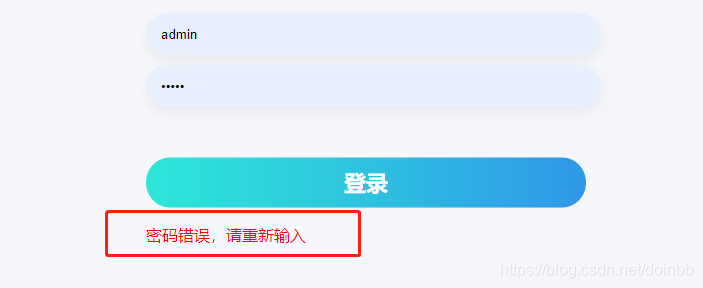基于Spring-Security自定义登陆错误提示信息
目录
- 一. 自定义实现
- 二. 实现自定义登陆页面
- Spring-Security登陆表单提交过程
- 那么异常一下是如何传递给前端的呢
- 获取方式
实现效果如图所示:

首先公布实现代码:
一. 自定义实现
import.org.springframework.security.core.userdetails.UserDetailsService类
并且抛出BadCredentialsException异常,否则页面无法获取到错误信息。
@Slf4j
@Service
public class MyUserDetailsServiceImpl implements UserDetailsService {
@Autowired
private PasswordEncoder passwordEncoder;
@Autowired
private UserService userService;
@Autowired
private PermissionService permissionService;
private String passwordParameter = "password";
@Override
public UserDetails loadUserByUsername(String username) throws AuthenticationException {
HttpServletRequest request = ContextHolderUtils.getRequest();
String password = request.getParameter(passwordParameter);
log.error("password = {}", password);
SysUser sysUser = userService.getByUsername(username);
if (null == sysUser) {
log.error("用户{}不存在", username);
throw new BadCredentialsException("帐号不存在,请重新输入");
}
// 自定义业务逻辑校验
if ("userli".equals(sysUser.getUsername())) {
throw new BadCredentialsException("您的帐号有违规记录,无法登录!");
}
// 自定义密码验证
if (!password.equals(sysUser.getPassword())){
throw new BadCredentialsException("密码错误,请重新输入");
}
List<SysPermission> permissionList = permissionService.findByUserId(sysUser.getId());
List<SimpleGrantedAuthority> authorityList = new ArrayList<>();
if (!CollectionUtils.isEmpty(permissionList)) {
for (SysPermission sysPermission : permissionList) {
authorityList.add(new SimpleGrantedAuthority(sysPermission.getCode()));
}
}
User myUser = new User(sysUser.getUsername(), passwordEncoder.encode(sysUser.getPassword()), authorityList);
log.info("登录成功!用户: {}", myUser);
return myUser;
}
}
二. 实现自定义登陆页面
前提是,你们已经解决了自定义登陆页面配置的问题,这里不做讨论。
通过 thymeleaf 表达式获取错误信息(我们选择thymeleaf模板引擎)
<p style="color: red" th:if="${param.error}" th:text="${session.SPRING_SECURITY_LAST_EXCEPTION.message}"></p>
<!DOCTYPE html>
<html xmlns:th="http://www.thymeleaf.org">
<head>
<meta charset="utf-8">
<meta http-equiv="X-UA-Compatible" content="IE=edge">
<title>XX相亲网</title>
<meta name="description" content="Ela Admin - HTML5 Admin Template">
<meta name="viewport" content="width=device-width, initial-scale=1">
</head>
<body class="mui-content">
<div id="d1">
<div class="first">
<img class="hosp" th:src="@{/images/dashboard/hospital.png}"/>
<div class="hospital">XX相亲网</div>
</div>
<div class="sufee-login d-flex align-content-center flex-wrap">
<div class="container">
<div class="login-content">
<div class="login-logo">
<h1 style="color: #385978;font-size: 24px">XX相亲网</h1>
<h1 style="color: #385978;font-size: 24px">登录</h1>
</div>
<div class="login-form">
<form th:action="@{/login}" method="post">
<div class="form-group">
<input type="text" class="form-control" name="username" placeholder="请输入帐号">
</div>
<div class="form-group">
<input type="password" class="form-control" name="password" placeholder="请输入密码">
</div>
<div>
<button type="submit" class="button-style">
<span class="in">登录</span>
</button>
</div>
<p style="color: red" th:if="${param.error}"
th:text="${session.SPRING_SECURITY_LAST_EXCEPTION.message}">
</p>
</form>
</div>
</div>
</div>
</div>
</div>
</body>
</html>
Spring-Security登陆表单提交过程
当用户从登录页提交账号密码的时候,首先由
org.springframework.security.web.authentication包下的UsernamePasswordAuthenticationFilter类attemptAuthentication()
方法来处理登陆逻辑。
public Authentication attemptAuthentication(HttpServletRequest request,
HttpServletResponse response) throws AuthenticationException {
if (postOnly && !request.getMethod().equals("POST")) {
throw new AuthenticationServiceException(
"Authentication method not supported: " + request.getMethod());
}
String username = obtainUsername(request);
String password = obtainPassword(request);
if (username == null) {
username = "";
}
if (password == null) {
password = "";
}
username = username.trim();
UsernamePasswordAuthenticationToken authRequest = new UsernamePasswordAuthenticationToken(
username, password);
// Allow subclasses to set the "details" property
setDetails(request, authRequest);
return this.getAuthenticationManager().authenticate(authRequest);
}
1. 该类内部默认的登录请求url是"/login",并且只允许POST方式的请求。
2. obtainUsername()方法参数名为"username"和"password"从HttpServletRequest中获取用户名和密码(由此可以找到突破口,我们可以在自定义实现的loadUserByUsername方法中获取到提交的账号和密码,进而检查正则性)。
3. 通过构造方法UsernamePasswordAuthenticationToken,将用户名和密码分别赋值给principal和credentials。
public UsernamePasswordAuthenticationToken(Object principal, Object credentials) {
super((Collection)null);
this.principal = principal;
this.credentials = credentials;
this.setAuthenticated(false);
}
super(null)调用的是父类的构造方法,传入的是权限集合,因为目前还没有认证通过,所以不知道有什么权限信息,这里设置为null,然后将用户名和密码分别赋值给principal和credentials,同样因为此时还未进行身份认证,所以setAuthenticated(false)。
到此为止,用户提交的表单信息已加载完成,继续往下则是校验表单提交的账号和密码是否正确。
那么异常一下是如何传递给前端的呢
前面提到用户登录验证的过滤器是UsernamePasswordAuthenticationFilter,它继承自AbstractAuthenticationProcessingFilter。
public void doFilter(ServletRequest req, ServletResponse res, FilterChain chain)
throws IOException, ServletException {
HttpServletRequest request = (HttpServletRequest) req;
HttpServletResponse response = (HttpServletResponse) res;
if (!requiresAuthentication(request, response)) {
chain.doFilter(request, response);
return;
}
if (logger.isDebugEnabled()) {
logger.debug("Request is to process authentication");
}
Authentication authResult;
try {
authResult = attemptAuthentication(request, response);
if (authResult == null) {
// return immediately as subclass has indicated that it hasn't completed
// authentication
return;
}
sessionStrategy.onAuthentication(authResult, request, response);
}
catch (InternalAuthenticationServiceException failed) {
logger.error(
"An internal error occurred while trying to authenticate the user.",
failed);
unsuccessfulAuthentication(request, response, failed);
return;
}
catch (AuthenticationException failed) {
// Authentication failed
unsuccessfulAuthentication(request, response, failed);
return;
}
// Authentication success
if (continueChainBeforeSuccessfulAuthentication) {
chain.doFilter(request, response);
}
successfulAuthentication(request, response, chain, authResult);
}
从代码片段中看到Spring将异常捕获后交给了unsuccessfulAuthentication这个方法来处理。
unsuccessfulAuthentication又交给了failureHandler(AuthenticationFailureHandler)来处理,然后追踪failureHandler
protected void unsuccessfulAuthentication(HttpServletRequest request,
HttpServletResponse response, AuthenticationException failed)
throws IOException, ServletException {
SecurityContextHolder.clearContext();
if (logger.isDebugEnabled()) {
logger.debug("Authentication request failed: " + failed.toString(), failed);
logger.debug("Updated SecurityContextHolder to contain null Authentication");
logger.debug("Delegating to authentication failure handler " + failureHandler);
}
rememberMeServices.loginFail(request, response);
failureHandler.onAuthenticationFailure(request, response, failed);
}
Ctrl + 左键 追踪failureHandler引用的类是,SimpleUrlAuthenticationFailureHandler。
private AuthenticationSuccessHandler successHandler = new SavedRequestAwareAuthenticationSuccessHandler(); private AuthenticationFailureHandler failureHandler = new SimpleUrlAuthenticationFailureHandler();
找到SimpleUrlAuthenticationFailureHandler类中的,onAuthenticationFailure()方法。
public void onAuthenticationFailure(HttpServletRequest request,
HttpServletResponse response, AuthenticationException exception)
throws IOException, ServletException {
if (defaultFailureUrl == null) {
logger.debug("No failure URL set, sending 401 Unauthorized error");
response.sendError(HttpServletResponse.SC_UNAUTHORIZED,
"Authentication Failed: " + exception.getMessage());
}
else {
saveException(request, exception);
if (forwardToDestination) {
logger.debug("Forwarding to " + defaultFailureUrl);
request.getRequestDispatcher(defaultFailureUrl)
.forward(request, response);
}
else {
logger.debug("Redirecting to " + defaultFailureUrl);
redirectStrategy.sendRedirect(request, response, defaultFailureUrl);
}
}
}
追踪到saveException(request, exception)的内部实现。
protected final void saveException(HttpServletRequest request,
AuthenticationException exception) {
if (forwardToDestination) {
request.setAttribute(WebAttributes.AUTHENTICATION_EXCEPTION, exception);
}
else {
HttpSession session = request.getSession(false);
if (session != null || allowSessionCreation) {
request.getSession().setAttribute(WebAttributes.AUTHENTICATION_EXCEPTION,
exception);
}
}
}
此处的
request.getSession().setAttribute(WebAttributes.AUTHENTICATION_EXCEPTION, exception);
就是存储到session中的错误信息,key就是
public static final String AUTHENTICATION_EXCEPTION = "SPRING_SECURITY_LAST_EXCEPTION";
因此我们通过thymeleaf模板引擎的表达式可获得session的信息。
获取方式
<p style="color: red" th:if="${param.error}"
th:text="${session.SPRING_SECURITY_LAST_EXCEPTION.message}">
</p>
需要注意:saveException保存的是Session对象所以需要使用${SPRING_SECURITY_LAST_EXCEPTION.message}获取。
以上为个人经验,希望能给大家一个参考,也希望大家多多支持我们。

